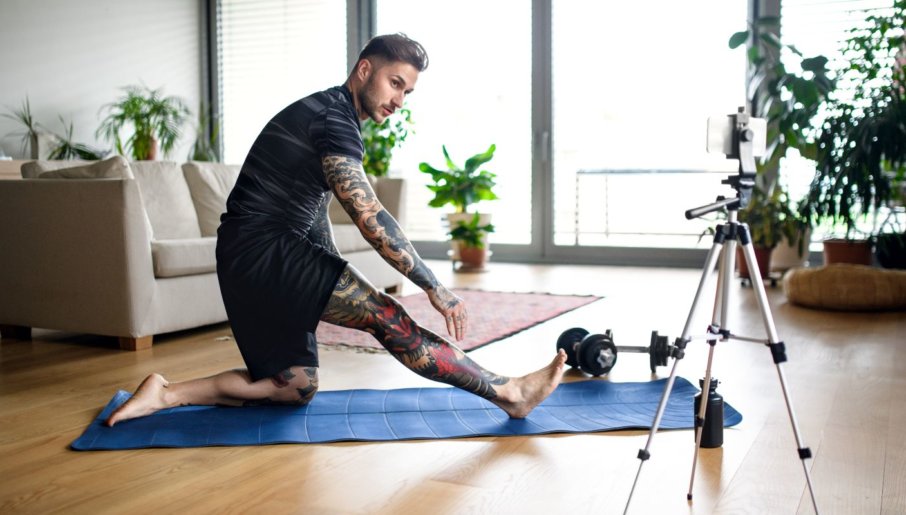Picture this:
You’re doing a trial session at a new gym or yoga studio. You walk in and it’s absolute chaos.
Dumbbells are strewn across the floor, sweaty mats are piled in the farthest corner from the studio door, and the machines are about as well-organized as a dog’s dinner.
What would you do?
You’d turn around and walk right back out, all the way to the better-organized gym across the street.
Now:
You and I both know you’d never leave your brick-and-mortar location in that state. But what about your online fitness platform?
The truth is that, if left unchecked, your website can become a messy, unorganized that’s hard for your customers to get the workout they want.
But there is a way to combat this. One that converts more customers, retains existing ones, and can help you to build a platform with a healthy revenue.
It’s simple: you build a well-organized content library.
In this article I’m going to show you exactly how to do it. Let’s go!
What Is A Fitness Content Library (And What Does It Do)?
Your fitness content library is the collection of every video on your website. Your members will see it as this page:
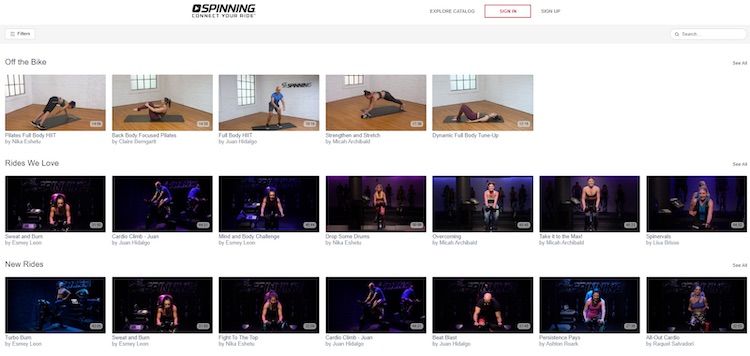
We call it a “content library” because it’s useful to picture your website as an actual library, and your videos as books on the shelves. Let me explain…
When you first launch your website it’s like a public library filled with empty shelves:
Each time you upload a video, you add a book to the shelves. The more videos you have, the bigger the library.
At the beginning, it’s easy for your customers to find the videos they’re looking for. If you only have 4 or 5 videos, you can rely on descriptive titles and thumbnails:

But, as your content library grows, finding things gets harder. Why?
Because there are more videos to scroll through, and it takes more effort to find the right video. This can give your members a negative experience. After all, one of the reasons they pay for your website is for convenience!
Now:
You might be thinking this doesn’t apply to your site, because you’ve only got a handful of videos. But, you’d be surprised how quickly you can reach this threshold!
This is where structure becomes important. Much like books in a library, you need to separate your content into logically searchable sections. (We’ll look at how to do that later.)
And, having this structure, can supercharge your online fitness business…
How Logical Structure Helps You Retain Customers
Your goal as a fitness professional is to empower your clients to exercise.
In your brick-and-mortar business, you typically achieve this through accessibility. You make finding the class, trainer, or equipment easy to access and use.
This might take the form of:
- Having a member of staff present at all times.
- Hanging visible class timetables.
- Creating a “PT wall” with a list of trainers.
- Accepting online bookings.
- Designating sections on the gym floor.
These strategies can help to reduce intimidation and ensure your clients can comfortably find what they’re looking for.
However…
When fitness businesses move online, they often forget this. But, using an online platform is no less intimidating.
Our resident Health and Fitness Business Consultant, KK Hart, says that feeling “out of the loop” or “ill-prepared” is the number one reason customers stop using online fitness platforms.
Structure can help you to combat this. For example, if you offer spin classes it can be useful to segment your content into…
- intensity
- duration
- training effect
…like Spinning Digital does here:
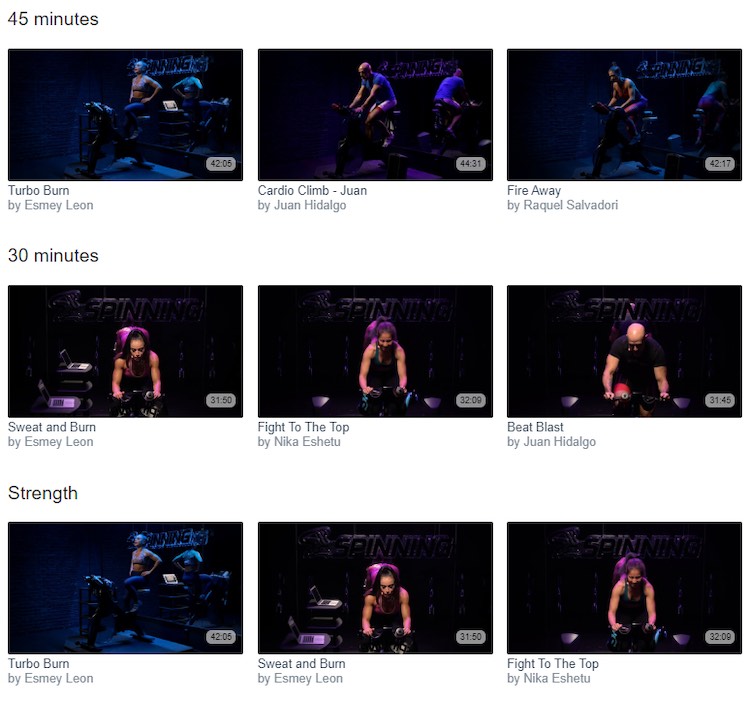
Using this kind of structure makes content easy to find. It’s kind of like you’re standing in the corner of your online studio saying:
“Need a quick 30 minute blast? That’s over there. Want to build your strength on the bike? No problem, that’s over there. Want to feel what it’s like to cycle the Tour de France? Of course, we’ve reserved a special corner for maniacs like you!”
In the next section I’m going to walk you through an example of a well-structured fitness library, so you can replicate this on your own platform. Let’s take a look.
How Barre Body Built A Healthy Content Library
Barre Body is a studio in Sydney, Australia. They also have a dedicated online fitness studio, Barre Body Online.
One of their major selling points is their well-structured content library:
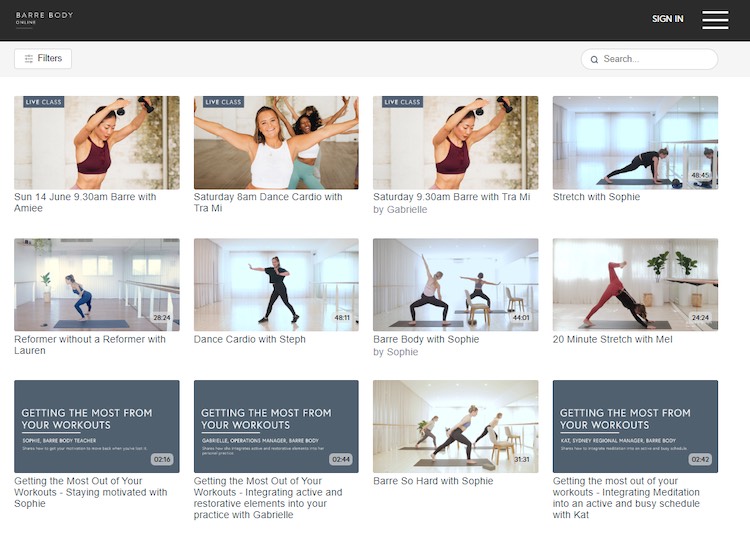
To ensure their customers always feel empowered to find the right workout for them, Barre Body applies tags to each video. This makes videos easy to filter.
These filters enables their customers to find workouts based on the:
- Training focus
- Level
- Duration
- Equipment
- Music
Here’s how these filters look in action:
These filters give customers the confidence to start a workout, because they know it matches everything they need.
Barre Body also goes a step further for the customers, creating “collections”. These are playlists of videos that belong to each other, that should be followed in sequence.
When a customer clicks on a collection they’ll see a screen like this, with a list of videos running down the side:
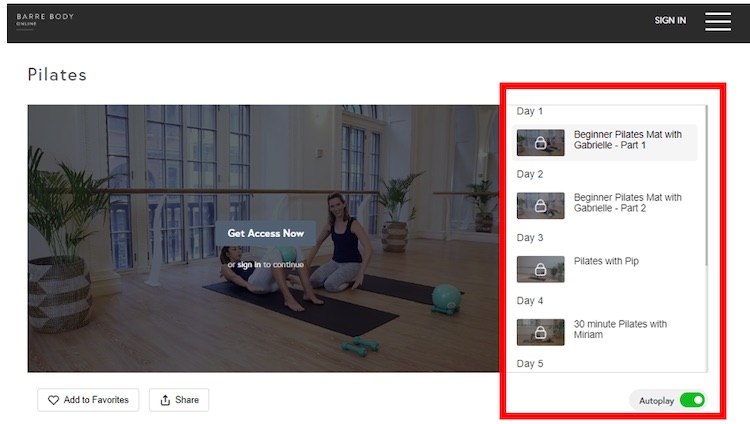
These collections are great for…
- time-bound challenges
- skill work
- progressive training plans
- offering variety
…because each video logically transitions into the next. This removes any decision making from the process, and makes the next video easy to find!
How you apply this to your business will vary: strength coaches need a different structure to yoga instructors; physiotherapists need a different one to Zumba teachers.
However, the principles of a well-structured library are always the same.
The 4 Principles Of A Powerful Content Library
Your content library will be built on 4 core principles:
- Relevant categories
- Custom filters
- High-quality content
- Data-driven decisions
Let’s take a closer look at them…
1. Use Relevant, Specific Categories To Split Your Videos
Your categories should be:
- Relevant: by making sense for the type of work you do
- Specific: easy for your customers to understand a video’s contents
The more depth you can provide, the better.
For example, Aerial Physique TV has built their library around skill level. The categories get progressively more intense, as does each video within the category:
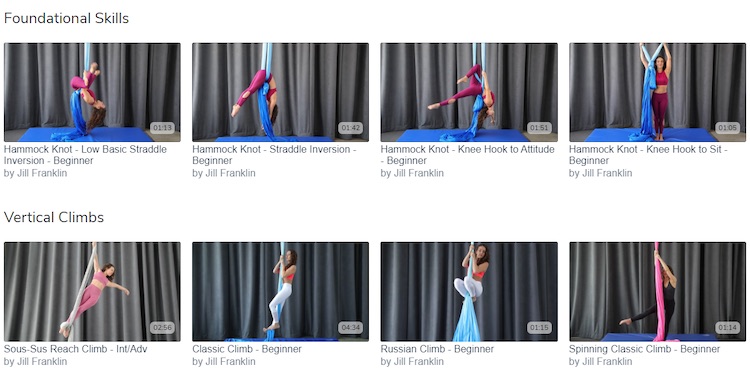
That means if you scroll from top to bottom, or left to right, the workouts become more intense. This provides a logical way for a client to work through the videos:
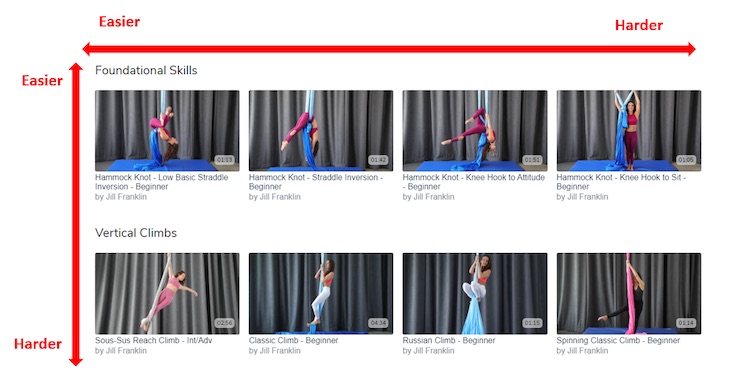
For you, this structure might be as simple as breaking your categories up into Strength, Cardio, and Flexibility. Perhaps you need to get more granular. That’s up to you!
But the more logical the structure, and the better it matches your customers’ expectations, the better.
2. Add Custom Filters To Make Content Easy To Find
You can assign custom filters to all of the videos on your website. These help you to make content easy for your audience to find, like Barre Body did in the example above.
You can apply as many custom filters to a video as you like, and it’s okay if a video shows up for 2 to 3 different ones. As long as it’s relevant and accurate, your customers won’t mind.
Now…
If you’ve already got a video library I hate to break it to you, but you’re going to need to go in and apply filters to all your existing content. I know it sucks, but it’ll be worth it!
You can watch a full tutorial on how to do this right here:
3. Focus On Quality Over Quantity
When you only have a few videos, it’s tempting to quickly pump your library full of content. But, quick videos are often low quality, and a sudden surge can overwhelm your customers.
It’s much more effective to slow down and consistently add higher quality videos over the long term. So, take your foot off the gas and remember quality is more important than quantity.
Here’s a great video from YouTuber, Matt D’Avella, on slowing down and looking at your business over a much longer time frame:
But how do you ensure that your content is high quality? Well, one way is to use analytics…
4. Use Data To Make Informed Decisions
Your videos are constantly gathering data like…
- watch times
- viewer counts
- community engagement
…that leave clues to exactly the content your customers really want. This will point you towards high-quality topics, ideas, and workouts that you should be creating more of.
Use your data to answer questions like:
- Which videos in my library get the most views?
- Which videos see the longest watch times?
- Where do I see the most engagement?
And create more videos like the ones you find.
You could also invert all of these questions to see where you get the least views, watch times, and engagement to highlight the content you shouldn’t continue to make.
Wrapping This Up…
Your fitness content library is all of the content on your website. To make your platform easier to use, and retain more customers, you need to add a logical structure to it.
You can do this by using:
- Relevant categories
- Custom filters
- High-quality content
- Data-driven decisions
These will empower your customers to use more of your content, and get better results from working with you.
If you want to learn more about content libraries, and the intricacies of how to optimize one, you should take a look at our guide on How To Optimize Your Content Library.
